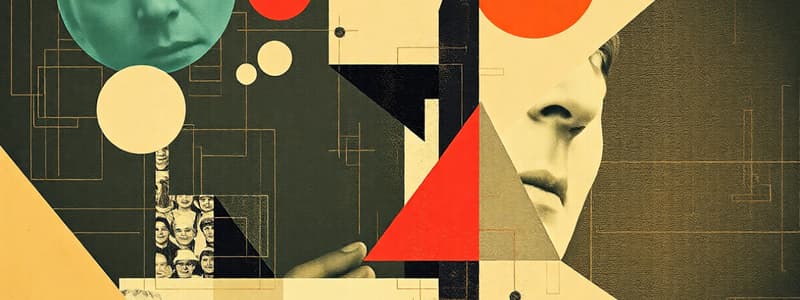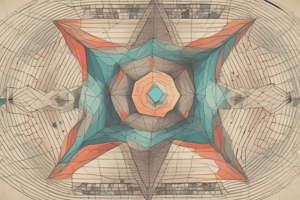Podcast
Questions and Answers
Geometry is the branch of mathematics that deals with shapes, sizes, positions, ______, and spatial relationships.
Geometry is the branch of mathematics that deals with shapes, sizes, positions, ______, and spatial relationships.
angles
Geometry helps children understand the world around them through ______ and spatial awareness.
Geometry helps children understand the world around them through ______ and spatial awareness.
visual
Geometry is not just about shapes; it's about problem-solving, ______, and connecting ideas.
Geometry is not just about shapes; it's about problem-solving, ______, and connecting ideas.
reasoning
Spatial ______: Understanding where objects are in space is a key component of geometry.
Spatial ______: Understanding where objects are in space is a key component of geometry.
Problem-______: Applying logical thinking to solve real-world problems demonstrates geometrical knowledge.
Problem-______: Applying logical thinking to solve real-world problems demonstrates geometrical knowledge.
A key connection to other subjects includes links to art, science, and ______ life.
A key connection to other subjects includes links to art, science, and ______ life.
Learning geometry builds a foundation for ______ and trigonometry.
Learning geometry builds a foundation for ______ and trigonometry.
Geometry is essential in building structures because it provides an understanding of shapes and ______.
Geometry is essential in building structures because it provides an understanding of shapes and ______.
Geometry is rooted in patterns, symmetry, and proportions in art and ______.
Geometry is rooted in patterns, symmetry, and proportions in art and ______.
Using maps and understanding directions involves spatial ______.
Using maps and understanding directions involves spatial ______.
Computer graphics, gaming, and animations rely on geometric ______.
Computer graphics, gaming, and animations rely on geometric ______.
Geometry is used in measuring spaces for furniture in the ______.
Geometry is used in measuring spaces for furniture in the ______.
Understanding angles and trajectories is important in ______.
Understanding angles and trajectories is important in ______.
In grades 1-2, key geometric concepts are basic shapes and ______ words.
In grades 1-2, key geometric concepts are basic shapes and ______ words.
In grades 3-4, students learn about symmetry, transformations, perimeter, and ______.
In grades 3-4, students learn about symmetry, transformations, perimeter, and ______.
In grades 5-6, angles, measuring tools (protractor), volume, and advanced ______ are studied.
In grades 5-6, angles, measuring tools (protractor), volume, and advanced ______ are studied.
Geometry encourages logical ______ and critical thinking in children.
Geometry encourages logical ______ and critical thinking in children.
Geometry enhances visual-______ skills, improving a child's perception.
Geometry enhances visual-______ skills, improving a child's perception.
Geometry helps children recognize ______ and relationships in their environment.
Geometry helps children recognize ______ and relationships in their environment.
Geometry improves problem-solving and ______ thinking, enhancing cognitive abilities.
Geometry improves problem-solving and ______ thinking, enhancing cognitive abilities.
Geometry boosts ______ and visual-spatial awareness, fostering creative potential.
Geometry boosts ______ and visual-spatial awareness, fostering creative potential.
Geometry prepares students for careers in ______ (Science, Technology, Engineering, Mathematics).
Geometry prepares students for careers in ______ (Science, Technology, Engineering, Mathematics).
Geometry enhances everyday ______-making skills through spatial understanding.
Geometry enhances everyday ______-making skills through spatial understanding.
Hands-______ Activities: Using manipulatives like blocks, tangrams, and geoboards is a teaching strategy for geometry.
Hands-______ Activities: Using manipulatives like blocks, tangrams, and geoboards is a teaching strategy for geometry.
Real-______ Connections: Linking geometric concepts to everyday experiences is important for learning.
Real-______ Connections: Linking geometric concepts to everyday experiences is important for learning.
Interactive ______: Using educational apps and games to teach geometry provides engagement.
Interactive ______: Using educational apps and games to teach geometry provides engagement.
______ Learning: Encouraging group activities to solve geometric problems fosters teamwork.
______ Learning: Encouraging group activities to solve geometric problems fosters teamwork.
In grades 1-2, shape ______ hunts are used to learn geometric principles.
In grades 1-2, shape ______ hunts are used to learn geometric principles.
Symmetry art projects and perimeter measurement tasks are used in grades -.
Symmetry art projects and perimeter measurement tasks are used in grades -.
Angle hunts and building 3D models are part of the curriculum in grades -.
Angle hunts and building 3D models are part of the curriculum in grades -.
To support geometry learning at home, encourage children to explore shapes and ______ in their surroundings.
To support geometry learning at home, encourage children to explore shapes and ______ in their surroundings.
To enhance spatial awareness, use ______ and building blocks for geometry learning at home.
To enhance spatial awareness, use ______ and building blocks for geometry learning at home.
Discuss real-world applications like map reading, cooking measurements, and ______ projects to support learning.
Discuss real-world applications like map reading, cooking measurements, and ______ projects to support learning.
Geometry involves understanding the relationship of objects in space, which is ______ in geometric learning.
Geometry involves understanding the relationship of objects in space, which is ______ in geometric learning.
To facilitate active learning and provide tactile experience with geometric concepts, we can leverage ______ activities.
To facilitate active learning and provide tactile experience with geometric concepts, we can leverage ______ activities.
Interactive technology and ______ enhance geometry education by offering dynamic visualizations and interactive problem-solving.
Interactive technology and ______ enhance geometry education by offering dynamic visualizations and interactive problem-solving.
Building 3D models and carrying out angle hunts enables students to actively engage with ______.
Building 3D models and carrying out angle hunts enables students to actively engage with ______.
Geometry includes understanding shapes, and spatial ______.
Geometry includes understanding shapes, and spatial ______.
Geometry is essential to the design and ______ of the world around us.
Geometry is essential to the design and ______ of the world around us.
Geometry is all about problem-solving skills, that increase ______ thinking.
Geometry is all about problem-solving skills, that increase ______ thinking.
Flashcards
What is Geometry?
What is Geometry?
Branch of math dealing with shapes, sizes, positions, angles, and spatial relationships.
Spatial Awareness
Spatial Awareness
Understanding where objects are in space.
Problem-Solving
Problem-Solving
Applying logical thinking to solve real-world problems.
Geometry in Architecture
Geometry in Architecture
Signup and view all the flashcards
Geometry in Art
Geometry in Art
Signup and view all the flashcards
Geometry in Navigation
Geometry in Navigation
Signup and view all the flashcards
Geometry in Technology
Geometry in Technology
Signup and view all the flashcards
Geometry for Grades 3-4
Geometry for Grades 3-4
Signup and view all the flashcards
Geometry for Grades 5-6
Geometry for Grades 5-6
Signup and view all the flashcards
Hands-On Geometry Activites
Hands-On Geometry Activites
Signup and view all the flashcards
Real-World Geometry Connections
Real-World Geometry Connections
Signup and view all the flashcards
Study Notes
- Geometry is important in early education
What is Geometry?
- Geometry concerns itself with shapes, sizes, positions, angles, and spatial relationships
- It aids children in grasping the world through visual and spatial understanding
- It is about connecting ideas through reasoning and problem-solving
Why Teach Geometry Early?
- Encourages spatial awareness, understanding of object placement
- Develops problem-solving skills by using logical thinking for real-world problems
- Connects to art, science, and everyday life
- Provides a groundwork for algebra and trigonometry
Geometry in Everyday Life
- Essential for comprehending structural shapes and angles in Architecture and Construction
- In Art and Design, geometry underlies patterns, symmetry, and proportions
- Spatial reasoning is needed for Navigation using maps and directions
- Computer graphics, animations and gaming rely on Technology
- It is found in Home design when measuring spaces for furniture, plus designing gardens
- Important for grasping angles and trajectories in Sports
Key Elementary Geometry Concepts
- Grades 1-2 learn basic shapes and positional words like above, below, and beside
- Grades 3-4 learn symmetry, transformations (flip, slide, rotate), perimeter, and area
- Grades 5-6 learn angles, use measuring tools like protractors, plus volume, and advanced transformations
Cognitive Development and Geometry
- It encourages logical reasoning and critical thinking
- Enhances visual-spatial skills
- It enables recognition of patterns and relationships in the environment
Benefits for Students
- Improves problem-solving and analytical thinking capabilities
- Boosts creativity and visual-spatial awareness
- Prepares for STEM careers (Science, Technology, Engineering, Mathematics)
- Enhances decision-making skills
Geometry Teaching Strategies
- Use Hands-On Activities that utilize manipulatives like blocks, tangrams, and geoboards
- Employ Real-World Connections, linking geometry to everyday experiences
- Use Interactive Technology such as educational apps and games
- Promote Collaborative Learning through group activities to solve geometric problems
Example Activities
- In grades 1-2, shape scavenger hunts and shape sorting are useful
- In grades 3-4, symmetry art projects and perimeter measurement tasks are good activities
- In grades 5-6, consider angle hunts and building 3D models
Supporting Geometry Learning at Home
- Inspire kids to discover shapes and patterns in their surroundings
- Develop spatial awareness, use puzzles and building blocks
- Explore applications like map reading, cooking measurements, and DIY projects
Studying That Suits You
Use AI to generate personalized quizzes and flashcards to suit your learning preferences.




